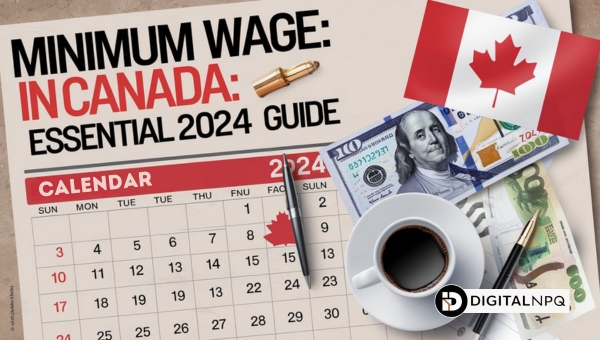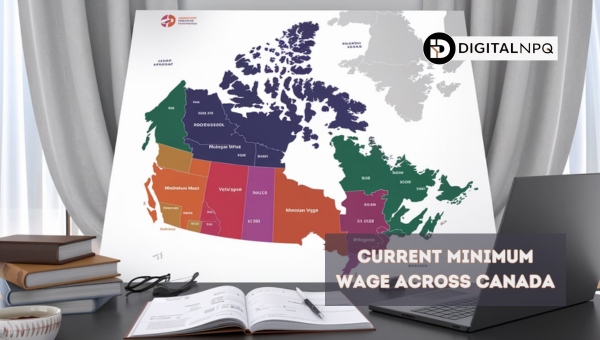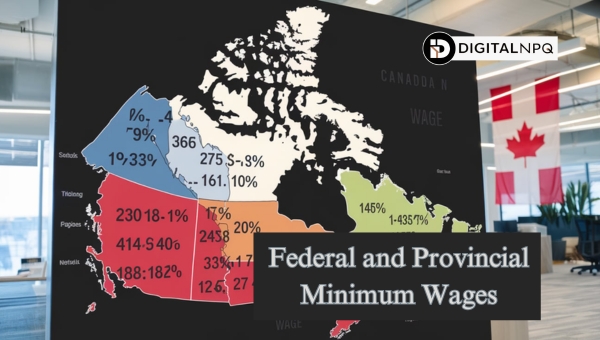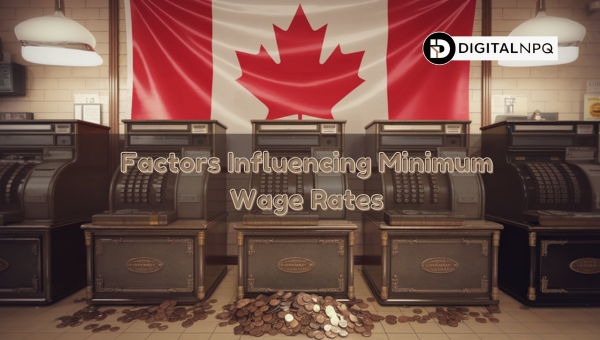Minimum Wage in Canada: Essential 2024 Guide

t might be difficult to navigate the complexities of Canada’s minimum wage, but businesses and employees must both grasp it.
In this article, we’ll delve into the details of federal and provincial minimum wage rates, explore how these wages are set and revised, and examine their impact on workers and the economy.
By the end, you’ll have a comprehensive grasp of minimum wage vs. living wage and how these figures shape the Canadian labor market. Let’s dive in and unlock the essential facts about minimum wage in Canada.
Current Minimum Wage Across Canada
The minimum wage in Canada varies significantly across its provinces and territories. This variation reflects the diverse economic conditions and living costs in different regions. As of April 2024.

Here are the current minimum wages:
- Alberta: C$15.00
- British Columbia: C$17.40
- Manitoba: C$15.30
- New Brunswick: C$15.30
- Newfoundland and Labrador: C$15.60
- Northwest Territories: C$16.05
- Nova Scotia: C$15.20
- Nunavut: C$19.00
- Ontario: C$16.55
- Prince Edward Island: C$15.40
- Quebec: C$15.75
- Saskatchewan: C$14.00
- Yukon: C$17.59
These rates undergo regular adjustments, often to align with inflation and shifts in living costs. For instance, British Columbia will see a rise in its minimum wage to C$17.40 effective June 1, 2024. Meanwhile, Ontario’s minimum wage is set to increase to C$17.20 on October 1, 2024.
Such adjustments are essential to help workers maintain a reasonable standard of living amidst rising expenses. While the minimum wage provides a baseline, it is important to note that it is often insufficient to cover all basic living expenses, particularly in high-cost areas. This discrepancy highlights the ongoing debates and discussions surrounding wage policies in Canada.
Understanding these minimum wage variations is crucial for both workers and employers. It helps ensure compliance with local laws and supports fair compensation practices across the country. Each province and territory has the autonomy to set its own minimum wage, catering to its unique economic landscape, which explains the differences in wage rates across Canada.
Bear in mind, this dynamic landscape requires regular review and updates to keep pace with the economic realities faced by workers nationwide.
Federal and Provincial Minimum Wages
Navigating the minimum wage landscape in Canada involves understanding both federal and provincial regulations. The federal minimum wage sets a baseline for federally regulated employees, while each province establishes its own rates to reflect local economic conditions.

This dual structure ensures that wage policies can be tailored to specific regional needs, providing a comprehensive approach to worker compensation.
Federal Minimum Wage
The federal minimum wage in Canada applies to employees in federally regulated sectors such as banking, transportation, and telecommunications. As of April 1, 2024, the federal minimum wage is set at C$17.30 per hour.
This rate is adjusted annually based on the Consumer Price Index (CPI) to ensure it keeps up with the cost of living. Approximately 30,000 workers benefit from this regulation, which aims to maintain fair wages across the country.
Provincial Minimum Wages
Each province in Canada has the autonomy to set its own minimum wage, leading to variations across the country. Here is a snapshot of the current rates:
- Alberta: C$15.00
- British Columbia: C$17.40
- Manitoba: C$15.30
- New Brunswick: C$15.30
- Newfoundland and Labrador: C$15.60
- Northwest Territories: C$16.05
- Nova Scotia: C$15.20
- Nunavut: C$19.00
- Ontario: C$16.55
- Prince Edward Island: C$15.40
- Quebec: C$15.75
- Saskatchewan: C$14.00
- Yukon: C$17.59
These rates reflect local economic conditions and cost of living, ensuring that workers in different regions receive appropriate compensation.
Also Read: Anchor Program New Jersey: Your Guide to Property Tax Relief
Factors Influencing Minimum Wage Rates
When discussing the minimum wage in Canada, it’s important to consider the various factors that influence its setting and adjustment.

These factors ensure that wage rates are fair and reflect the current economic landscape. Two primary factors that play a significant role are economic conditions and employment legislation.
Economic Factors
Economic conditions greatly impact decisions regarding minimum wage rates. Here are some key economic elements that are considered:
- Inflation Rates: Higher inflation often leads to increased minimum wages to ensure that workers’ purchasing power remains stable.
- Unemployment Rates: Low unemployment can result in higher wages as employers strive to attract and retain workers.
- Cost of Living: Regions with a higher cost of living typically see higher minimum wages to help workers meet their basic needs.
- Economic Growth: A growing economy may support higher wages as businesses experience increased revenue and profitability.
Employment Legislation
Legislative measures are another crucial factor in setting minimum wage rates. Here are some legislative aspects that influence wage determination:
- Minimum Wage Laws: Each province has its own laws governing the minimum wage, which are periodically reviewed and adjusted.
- Collective Bargaining Agreements: Unions play a role in negotiating wages, often resulting in higher minimum wages in sectors with strong union representation.
- Government Policies: Policies aimed at economic stability and growth can influence wage regulations, ensuring that wages keep pace with economic changes.
- Labor Standards: Regulatory standards set by the government ensure that wages are fair and equitable, protecting workers from exploitation.
Current Trends and Revisions
Navigating the landscape of minimum wage in Canada requires understanding the trends and revisions that shape it. This section delves into how often minimum wage is reviewed and the mechanisms ensuring it keeps pace with inflation.
How Often Is the Minimum Wage Revised?
Minimum wage revisions in Canada are typically conducted on an annual basis. Here’s a breakdown of how often these reviews occur:
- Annual Reviews: Most provinces and territories review their minimum wage rates every year. This ensures wages remain relevant in changing economic conditions.
- Consumer Price Index (CPI) Adjustments: Many regions tie their minimum wage increases to the CPI, reflecting cost of living changes.
- Scheduled Increases: Some provinces set predetermined dates for wage adjustments, providing predictability for workers and employers.
- Legislative Reviews: In addition to routine adjustments, legislative reviews may prompt changes based on broader economic policies.
- Sector-Specific Adjustments: Certain sectors might see more frequent revisions due to union negotiations or special economic conditions.
Minimum Wage Keeps Pace with Inflation
Ensuring that minimum wages keep up with inflation is crucial for maintaining workers’ purchasing power. Here’s how this is typically managed:
- CPI-Based Increases: Many provinces, like British Columbia, link their minimum wage adjustments directly to the Consumer Price Index.
- Annual Adjustments: Regular yearly reviews often incorporate inflation rates to ensure wages do not lag behind rising living costs.
- Additional Percentage Increases: Some provinces, such as Nova Scotia, add an extra percentage to the inflation rate to further safeguard against cost of living increases.
- Policy Mechanisms: Governments may implement policies to automatically adjust minimum wages based on inflation data.
- Economic Indicators: Broader economic indicators, beyond just inflation, can also influence wage adjustments to more holistically reflect economic conditions.
By understanding these trends and mechanisms, workers and employers can better navigate the evolving landscape of minimum wages in Canada.
Also Read: Capital One Settlement: All You Need to Know
Comparing Different Types of Wages
Understanding the differences between various wage types is essential for grasping the economic landscape in Canada. In this section, we will dive into comparisons such as minimum wage versus living wage, and how they stack up against rental costs.
Moreover, we will explore disparities between wages for entry-level and experienced workers, the distinction between hourly and salaried incomes, and the nuances of overtime pay versus regular pay.
Minimum Wage vs. Living Wage
Minimum Wage:
- The minimum wage is the lowest legal amount an employer can pay an employee.
- It is set by federal or provincial governments and varies across Canada.
- Minimum wage does not necessarily cover all basic living expenses.
Living Wage:
- The living wage is a calculated amount that allows individuals to afford a decent standard of living.
- This wage considers the cost of essentials such as housing, food, transportation, and childcare.
- The living wage is often higher than the minimum wage, highlighting the gap between legal pay and actual living costs.
Comparison:
- Purpose: Minimum wage aims to provide a basic income floor, while the living wage ensures a decent quality of life.
- Calculation: Minimum wage is set by law, often based on economic conditions, whereas the living wage is calculated by non-profit organizations considering the specific cost of living in a region.
- Impact: Workers earning the minimum wage may struggle to meet all necessary expenses, whereas those earning a living wage can cover basic needs more comfortably.
Minimum Wage vs. Rental Wage
Minimum Wage:
- Provides a basic income floor for workers.
- Often insufficient to cover the cost of living, especially in urban areas.
Rental Wage:
- Refers to the income needed to afford rent without spending more than 30% of one’s income on housing.
- Rental wage often exceeds the minimum wage in many Canadian cities.
Analysis:
- Disparity: There is a significant gap between the minimum wage and the rental wage, particularly in expensive housing markets.
- Challenges: Minimum wage workers face difficulties affording rent, leading to financial stress and potential housing insecurity.
- Solution: Addressing this disparity may involve increasing the minimum wage or providing housing subsidies.
Entry-Level Wage vs. Experienced Worker Wage
Entry-Level Wage:
- Typically set at or near the minimum wage.
- Reflects the lack of experience and skills of new employees.
Experienced Worker Wage:
- Higher wages that reflect the skills, experience, and productivity of seasoned employees.
- Often significantly higher than entry-level wages, recognizing the value of experience.
Disparities:
- Earnings Gap: The gap between entry-level and experienced worker wages can be substantial.
- Career Progression: Employees can expect wage increases as they gain experience and skills.
- Wage Compression: In some sectors, the difference in wages may be smaller, leading to wage compression issues.
Hourly Wage vs. Salaried Income
Hourly Wage:
- Paid per hour worked.
- Employees may receive overtime pay for extra hours worked beyond a standard workweek.
- Provides flexibility but can be less predictable.
Salaried Income:
- A fixed annual amount, regardless of hours worked.
- Often includes benefits such as health insurance and paid time off.
- Provides stability but may not compensate for extra hours worked.
Comparison:
- Benefits: Hourly wage earners benefit from overtime pay, while salaried employees enjoy stability and benefits.
- Flexibility vs. Stability: Hourly wages offer flexibility in work hours, whereas salaried income provides financial stability.
- Work-Life Balance: Salaried workers may face challenges in maintaining work-life balance due to fixed income without overtime compensation.
Overtime Pay vs. Regular Pay
Regular Pay:
- The standard wage for normal hours worked.
- Provides a predictable income based on the agreed hourly or salaried rate.
Overtime Pay:
- Typically calculated at 1.5 times the regular hourly wage for hours worked beyond a standard workweek.
- Encourages fair compensation for additional hours worked.
Differences:
- Rate: Overtime pay is higher than regular pay, reflecting the extra effort and time put in by employees.
- Incentive: Overtime pay acts as an incentive for employees to work beyond their regular hours.
- Fair Compensation: Ensures that employees are fairly compensated for the additional time and effort they contribute.
By understanding these distinctions, workers can better navigate their employment options and employers can ensure fair compensation practices.
FAQs
What is Canada’s lowest salary?
The lowest salary in Canada is determined by the minimum wage, which varies by province and territory. As of 2024, the provincial minimum wages range from $14.00 to $19.00 per hour.
How much does Canada pay per hour?
Hourly pay in Canada depends on the province or territory. The federal minimum wage is set at $17.30 per hour as of April 1, 2024, while provincial rates vary.
What is a livable hourly wage in Canada?
A livable hourly wage in Canada is higher than the minimum wage and varies by location, covering basic expenses like housing, food, and transportation. It typically ranges from $20 to $25 per hour, depending on the cost of living in different areas.
Conclusion
In essence, the minimum wage in Canada is a critical factor in ensuring fair pay for workers across various provinces and territories. Understanding the distinctions between federal and provincial rates, and how these rates are set and revised, is crucial for both employees and employers.
The impact of these wages on the economy and individuals’ living standards further underscores their importance. By staying informed, you can better navigate the complexities of the minimum wage landscape. To dive deeper into related topics and stay updated, explore more insightful blogs on our site!
